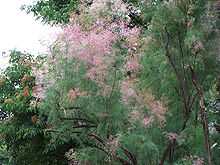Tamarix ramosissima
| Tamarix ramosissima Saltcedar | |
|---|---|
 | |
| Scientific classification | |
| Kingdom: | Plantae |
| (unranked): | Angiosperms |
| (unranked): | Eudicots |
| (unranked): | Core eudicots |
| Order: | Caryophyllales |
| Family: | Tamaricaceae |
| Genus: | Tamarix |
| Species: | T. ramosissima |
| Binomial name | |
| Tamarix ramosissima Ledeb. | |
Tamarix ramosissima, commonly known as Saltcedar or Salt Cedar, is a deciduous arching shrub with reddish stems, feathery, pale green foliage, and characteristic small pink flowers.
Description
Tamarix ramosissima is a hardy shrub or small tree native to Europe and Asia. It is a vigorous, deciduous shrub grown for its ornamental reddish stems, its showy plumes of flowers and its unusual feathery leaves. Its hardiness and tolerance for poor soil make it a popular, easy to grow shrub. It can grow up to 8 m in height and up to 5 m in width. It can be used as a screen, windbreak, informal hedge or specimen shrub.[1]
Tamarix ramosissima produces upright racemes of small, pink, five-petaled flowers from late summer to early autumn which cover the new wood of the plant. It is tolerant of many soil types but prefers a well drained, light or sandy soil in full sun. This plant is considered an invasive species in warmer climates.[1]
Invasive species
Tamarix ramosissima is a major invasive plant species in the Southwestern United States and Desert Region of California, consuming large amounts of groundwater in riparian and oases habitats.[1] The balance and strength of the native flora and fauna is being helped by various restoration projects, by removing Tamarisk groves as if they were noxious weeds.[2]
| Wikimedia Commons has media related to Tamarix ramosissima. |
See also
- Introduced species
- Invasive species
- Category: Invasive plant species
Further reading
- CISR - Saltcedar Center for Invasive Species Research summary on Saltcedar.
References
- ↑ 1.0 1.1 1.2 Zouhar, Kris. 2003. Tamarix spp. In: Fire Effects Information System, [Online]. U.S. Department of Agriculture, Forest Service, Rocky Mountain Research Station, Fire Sciences Laboratory.
- ↑ Afton Canyon Riparian Restoration Project Fourth Year Status Report. Bureau of Land Management. accessed 6/20/2010